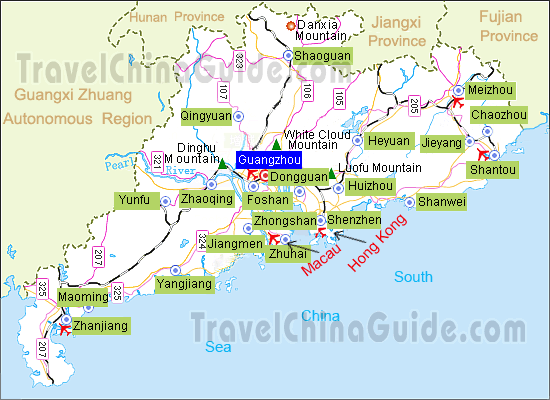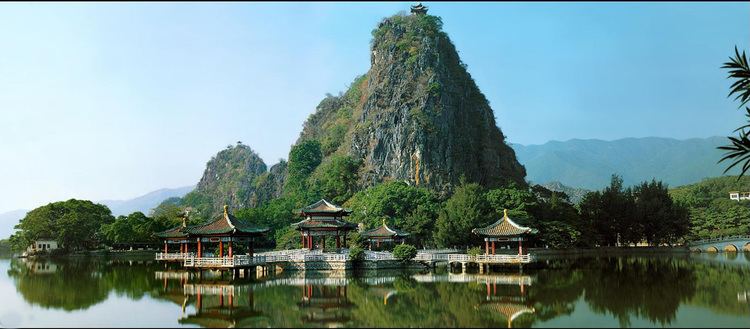Country China Area 14,891.23 km2 | Population 507,834 (2000) University Zhaoqing University | |
 | ||
Map of Zhaoqing
Zhaoqing, formerly romanized as Shiuhing, is a prefecture-level city in Guangdong Province, China. During the 2010 census, its population was 3,918,467, with 1,232,462 living in the urbanized areas of Duanzhou District and Gaoyao County. The prefectural seat—excluding Seven Star Crags—is fairly flat, but thickly forested mountains lie just outside its limits. Numerous rice paddies and aquaculture ponds are found on the outskirts of the city. Sihui and the southern districts of the prefecture are considered part of the Pearl River Delta.
Contents
- Map of Zhaoqing
- Shenzhen what to do seafood street
- Name
- History
- Geography
- Climate
- Administration
- Primary industries
- Secondary industries
- The 10 Projects
- Companies with a presence in Zhaoqing
- Education
- Colleges and universities
- Transportation
- References
Formerly one of the most important cities in southern China, Zhaoqing lost importance during the Qing and is now primarily known for tourism and as a provincial "college town". Residents from Guangzhou, Shenzhen, and the other cities of the Pearl River Delta visit it for weekend excursions. It is also a growing manufacturing center.
Shenzhen what to do seafood street
Name

Zhaoqing was known to the Qin and Han as Gaoyao. It was renamed Duanzhou from its role as the seat of Duan Prefecture under the Sui. The present name, meaning "Beginning Auspiciousness", was bestowed on the area by Emperor Huizong of the Song in 1118. "Zhaoqing" is the pinyin romanization; the earlier Postal Map form "Shiuhing" derives from the name's Cantonese pronunciation.
History
Gaoyao was located on the south bank of the Xi River, named for its district's principal feature: the river's Lingyang Gorge (then known as "Gaoyao"). In the late 6th and early 7th centuries, the administration was relocated to Duanzhou on the opposite bank of the river, which became an important administrative and military center of the southern Sui Empire.
When the Portuguese arrived in the 16th century, Zhaoqing was still an important center, serving as the seat of the Viceroy of Liangguang (Guangdong and Guangxi). Matteo Ricci's On the Christian Expedition among the Sinae tells of the early visits of Macanese-based Europeans to Zhaoqing. The Viceroy Chen Rui (陈瑞) summoned Macao's mayor and bishop in the early 1580s, but the town sent its auditor Mattia Penella and the Italian Jesuit Michele Ruggieri in their place in 1582. After several false starts, Ruggieri and Matteo Ricci were allowed to establish their residence in the city, the first Jesuit mission house on mainland China, after Zhaoqing's governor Wang Pan learned of Ricci's skill as a mathematician and cartographer. Ricci drew the first modern Chinese map of the world in Zhaoqing in 1584. Ruggieri left for Rome in 1588 but Ricci remained until the next year, when a new viceroy expelled him from the city and obliged the Jesuits to relocate to Shaozhou (now Shaoguan).
During the Fall of the Ming in the mid-17th century, Zhaoqing served as the capital of the Prince of Gui's Southern Ming resistance, with the prince styling himself the Yongli Emperor. The town fell in 1650 and the prince relocated to Guilin and then various locations in Guangxi, Yunnan, and Burma. The Jesuits Andreas Wolfgang Koffler and, later, Michał Boym stayed for some time at his court.
The Qing viceroy of Liangguang relocated to Guangzhou but Zhaoqing remained a commandery seat, overseeing the counties of Gaoyao, Guangning, Deqing, Sihui, and Kaijian and Fengchuan (since combined into Fengkai); Gaoming (now part of Foshan); Xinxing (now part of Yunfu); Heshan, Kaiping, and Enping (now part of Jiangmen); and Yangchun and Yangjiang (now part of Yangjiang's separate prefecture).
Geography
Zhaoqing is located 110 km (68 mi) northwest of Guangzhou, in the west Pearl River Delta. It lies on the north shores of the Xi River, which flows from west to east, and opposite of Gaoyao. A plain area lies to the south and west of Zhaoqing, with mountains to the east and north.
Climate
The city has a monsoon-influenced humid subtropical climate (Köppen climate classification Cfa). The yearly average temperature is 22.3 °C (72.1 °F), and annual precipitation is 1,605 mm (63.2 in).
Administration
Zhaoqing has jurisdiction over 3 districts, 4 counties and 1 County-level city:
Primary industries
The rich local resources within the mountainous regions include coal, limestone, copper, lead, zinc, granite, gold, sulfur, gypsum and other minerals.
In the agriculture sector, the fertile plains yield paddy rice, sugar cane, aquatic products, fruits, rosin and cassia bark. Horticulture and farming contribute greatly to the local economy. The industries of Poultry farming and animal husbandry are also seeking to modernize their technology and management.
The forests in the mountainous regions of the city provide a rich source for herbal medicines and other materials like rosin and casia bark that are harvested from various forest plants.
Secondary industries
Food and beverages, building materials, electronics, micro bioengineering, chemicals, equipment and machinery, textile and garments are the pillar industries. Duanzhou, Gaoyao and Sihui area being developed as the export-oriented industrial bases. Yunfu is a major area for the production of sulfur and iron.
To facilitate industrial development in Zhaoqing, the local government has made great efforts in establishing various industrial zones / parks in the city. The largest one is the Guangdong Zhaoqing High-tech Industrial Development Zone, with an area of 109 km2 (42 sq mi), that consists of two industrial parks, Sanrong Industrial Park and Dawang Industrial Park, of areas 9 km2 (3.5 sq mi) and 100 km2 (39 sq mi) respectively. Dawang is facilitated as an export processing and trade zone.
The 10 Projects
The Zhaoqing local government attracts capital investment by promoting the city to private and foreign investors, and by developing industrial parks in modern standard. Making the best use of its natural environment, Zhaoqing aims to become a garden city, ecological city and modernized large city in China.
In five year's time (2003–2007), the city government will implement 10 big projects:
There is now a memorial plaque in Zhaoqing to commemorate Ricci's six-year stay there as well as a building set up as a "Ricci Memorial Centre" although the building itself does not date back to the time of the priest as it was built in the 1860s.
Companies with a presence in Zhaoqing
Education
The city government of Zhaoqing is currently seeking to improve its higher education system and preserve cultural resources. Zhaoqing has a university and is also home to a campus of Guangdong University of Finance. There is also Zhaoqing Foreign Language College, a Canadian-American School and numerous other schools including those specializing in foreign language study.
Colleges and universities
Transportation
Zhaoqing is served by railways and highways. Direct train and bus services connect it to Guangzhou, Hong Kong and other cities in Guangdong. Major roadways include Interstates 321 and 324 and the Guang-Zhao and Guang-Wu Expressways. The Sanmao Railway also runs through Zhaoqing. It is connected with Hong Kong via the KCRC Guangdong Through Train service from Zhaoqing Railway Station. Hong Kong owned and based Chu Kong Passenger Transport Co., Ltd also runs daily express catamaran ferries between Zhaoqing and Hong Kong.
Within the city, the primary form of public transportation is the 28 public bus routes.
